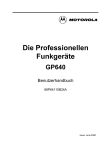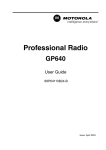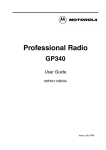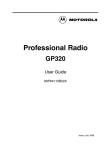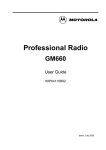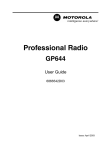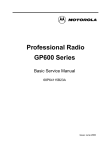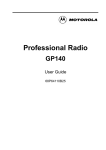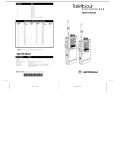Download Motorola GP640 User guide
Transcript
Professional Radio GP640 User Guide 68P64110B24A Issue: June 2000 6 5 4 3 2 1 8 7 9 10 11 CONTENTS Operation and Control Functions . . . . . . . . Radio Controls . . . . . . . . . . . . . . . . . . . Programmable Buttons . . . . . . . . . . . . . Audio Signal Tones . . . . . . . . . . . . . . . . 3 3 4 5 Getting Started . . . . . . . . . . . . . . . . . . . . . 7 Battery Information. . . . . . . . . . . . . . . . . . . Battery Care and Tips . . . . . . . . . . . . . . Recycling or Disposal of Batteries . . . . Charging the Battery . . . . . . . . . . . . . . . 7 7 8 8 Accessory Information . . . . . . . . . . . . . . 9 Attaching the Battery . . . . . . . . . . . . . . . . . 9 Removing the Battery. . . . . . . . . . . . . . . . . 9 Attaching the Antenna . . . . . . . . . . . . . . . 10 Removing the Antenna. . . . . . . . . . . . . . . 10 Attaching the Belt Clip . . . . . . . . . . . . . . . 11 Removing the Belt Clip. . . . . . . . . . . . . . . 11 Attaching the Side Connector . . . . . . . . . 12 Radio Operation . . . . . . . . . . . . . . . . . . . 13 Radio Registration . . . . . . . . . . . . . . . . . . .14 Radio Calls . . . . . . . . . . . . . . . . . . . . . . . .15 Making a Call. . . . . . . . . . . . . . . . . . . . . . .15 Contact List . . . . . . . . . . . . . . . . . . . . . . . .15 User Absent. . . . . . . . . . . . . . . . . . . . . . . .15 Dedicated Calls . . . . . . . . . . . . . . . . . . . . .16 Ending a Call . . . . . . . . . . . . . . . . . . . . . . .16 Cancelling a Call . . . . . . . . . . . . . . . . . . . .16 Receiving a Call. . . . . . . . . . . . . . . . . . . . .17 Receiving a Call on a OACSU System . . 17 Receiving a Call on a FOACSU System. 17 Missed Calls . . . . . . . . . . . . . . . . . . . . . . .18 Call Diversion . . . . . . . . . . . . . . . . . . . . . .19 Emergency Calls . . . . . . . . . . . . . . . . . . . .20 Personality . . . . . . . . . . . . . . . . . . . . . . . .21 MPT . . . . . . . . . . . . . . . . . . . . . . . . . . . . . .21 Talkgroup. . . . . . . . . . . . . . . . . . . . . . . . . .22 Fixed and Dynamic Groups . . . . . . . . .22 Conventional Mode . . . . . . . . . . . . . . . . . .23 Personality Selection . . . . . . . . . . . . . . . . .24 Turning the Radio On-Off. . . . . . . . . . . . . 13 Adjusting the Radio’s Volume . . . . . . . . . 13 1 English CONTENTS Radio Overview . . . . . . . . . . . . . . . . . . . . 3 Features . . . . . . . . . . . . . . . . . . . . . . . . . 25 Voice Recorder . . . . . . . . . . . . . . . . . . . . 25 Safety Information . . . . . . . . . . . . . . . . . 27 Safe and Efficient Operation . . . . . . . . . . Exposure to Radio Frequency Energy . . . Radio Operation and EME Exposure . . . . Electromagnetic Interference/ Compatibility. . . . . . . . . . . . . . . . . . . . . . . Operational Warnings . . . . . . . . . . . . . . . Vehicles with an Air Bag . . . . . . . . . . . Potentially Explosive Atmospheres . . . Batteries . . . . . . . . . . . . . . . . . . . . . . . Blasting Caps and Areas. . . . . . . . . . . Operational Cautions . . . . . . . . . . . . . . . . Damaged Antennas . . . . . . . . . . . . . . Batteries . . . . . . . . . . . . . . . . . . . . . . . General Radio Care . . . . . . . . . . . . . . . . . 27 27 28 28 28 28 28 28 29 29 29 29 29 Computer Software Copyright The products described in this manual may include copyrighted computer programmes stored in semiconductor memories or other media. Laws in the United States of America and other countries preserve for Motorola Europe and Motorola Inc. certain exclusive rights for copyrighted computer programmes, including the right to copy or reproduce in any form the copyrighted computer programme. Accordingly, any copyrighted computer programmes contained in the products described in this manual may not be copied or reproduced in any manner without the express written permission of the holders of the rights. Furthermore, the purchase of these products shall not be deemed to grant either directly or by implication, estoppel, or otherwise, any licence under the copyrights, patents, or patent applications of the holders of the rights, except for the normal non-exclusive royalty free licence to use that arises by operation of the law in the sale of the product. English 2 RADIO OVERVIEW Top Button (programmable) Recommended as Emergency button. 8. The numbers below refer to the illustrations on the inside front cover. LED Indicator Green: Flashes to indicate NO SERVICE. Red: On when radio is transmitting. Red Flashing: When transmitting - battery low. Green: On to indicate monitor mode active (Conventional Mode). Red Flashing: When receiving - channel busy (Conventional Mode). 9. Microphone 1. 10. Antenna This user guide covers the operation of the GP640 Portable Radio. Please read pages 27 to 29 before using this radio OPERATION AND CONTROL FUNCTIONS Radio Controls Rotary Knob Used as a multi-function scroll key and as a channel selector in Conventional mode. 2. On-Off / Volume Knob Used to turn the radio on or off, and to adjust the radio’s volume. 3. Clear Button (Side Button 1) Used to cancel a call, clear down at the end of a call or Carrier Monitor (Conventional mode). 4. Push to Talk Button (PTT) Press and hold down this button to talk, release it to listen. 5. Side Button 2 Personality button, otherwise programmable. 6. Side Button 3 (programmable) 11. Accessory Connector Connects headsets, remote speaker/microphones and other accessories. Replace attached dust cap when not in use. 3 English RADIO OVERVIEW 7. RADIO OVERVIEW Programmable Buttons Several of your radio buttons can be programmed (by your dealer) to activate the radio features. The following table shows the features that can be assigned to the Top button and the Side Buttons 2 and 3. Feature Description Dedicated Call/ Emergency To make a call to a pre-determined number. This can be an emergency number, effectively activating an Emergency Call. Personality To select one of two radio personalities, (e.g. MPT trunking system or conventional system). This will normally be Side Button 2. Missed Calls To select the Missed Call list. This is a list of calls received and stored by the radio when you were unable to take the call. Record/Play-back (Voice Recorder)* To record/play-back incoming calls or memo using voice recorder feature. *Voice Storage option board needs to be installed and enabled to activate voice storage features. English 4 Audio Signal Tones (Normal Tones) Tone Self test Signal Tone Signal Description Low pitched tone Description Key click Confidence tone when any key pressed or speech limitation alert. Fail tone Hardware error or Call timed out (conventional mode). Power up. Tone A Call clear indication. Tone B Traffic channel allocated or PTT/ Mic/ Loudspeaker enabled. Tone I Low battery warning. Tone K1 Voice Storage recording. Tone C1 System busy. Tone K2 Voice Storage warning. Tone C2 Unavailable. Tone K3 Voice Storage full. Tone C3 Called party busy. Tone L1 1st Personality. Tone C4 Invalid number. Tone L2 2nd Personality. Call set up in progress, wait for further indications. Tone M1 Talkgroup Confirmation. Tone D Tone M2 Talkgroup unavailable. Tone N1 Out of range alert. Tone F Transaction confirmed, called unit will call back. Tone G Look at display for call set up or System information. Tone H Invalid entry. Ring tones Standard/ English/French/ General Incoming call, press PTT, then wait for further indications. 5 English RADIO OVERVIEW High pitched tone RADIO OVERVIEW Audio Signal Tones (Alternative) Tone Signal Description High to Low pitched tones Tone Signal Tone H Invalid entry. Key click Confidence tone when any key pressed or Speech limitation alert. Fail tone Hardware error or Call timed out (conventional mode). Tone I Low battery warning. System busy. Tone K1 Voice Storage recording. Unavailable. Tone K2 Voice Storage warning. Tone K3 Voice Storage full. Tone L1 1st Personality. Tone L2 2nd Personality. Tone M1 Talkgroup Confirmation. Tone M2 Talkgroup unavailable. Tone N1 Out of range alert. Description Self test Power up. Tone A Call clear indication. Traffic channel allocated or PTT/ Mic/ Loudspeaker enabled. Tone B Tone C1 Tone C2 Tone C3 Called party busy. Tone C4 Invalid number. Tone D Call set up in progress, wait for further indications. Transaction confirmed, called unit will call back. Tone F Look at display for call set up or System information. Tone G English 6 Ring tones Standard/ English/French/ General Incoming call, press PTT, then wait for further indications. • Charging a hot battery (above 35°C) results in reduced discharge capacity, affecting the performance of the radio. Motorola rapid-rate battery chargers contain a temperature-sensing circuit to ensure that the battery is charged within these temperature limits. This product is powered by a nickel-cadmium (NiCd), nickel-metal-hydride (NiMH), or lithium-ion rechargeable battery. • New batteries can be stored up to two years without significant cycle loss. Store new/unused batteries in a cool dry area. The following battery tips will help you obtain the highest performance and longest cycle life from your Motorola rechargeable battery. • Batteries which have been in storage should be charged overnight. • Do not return fully charged batteries to the charger for an “extra boost”. This action will significantly reduce cycle life. • Do not leave your radio and battery in the charger when not charging. Continuous charging will shorten battery life. (Do not use your charger as a radio stand.) • For optimum battery life and operation use only Motorola brand chargers. They were designed to operate as an integrated energy system. BATTERY INFORMATION Battery Care and Tips • Charge your new battery overnight (14-16 hrs) before using it to obtain maximum battery capacity and performance. • Charging in non-Motorola equipment may lead to battery damage and void the battery warranty. • When charging a battery that is attached to the radio, turn the radio off to ensure a full charge. • The battery should be at about 25°C (room temperature) whenever possible. Charging a cold battery (below 10°C) may result in leakage of electrolyte and ultimately, in failure of the battery. 7 English GETTING STARTED GETTING STARTED GETTING STARTED Recycling or Disposal of Batteries Charger LED NiCd At the end of its useful life, the NiCd battery can be recycled. However, recycling facilities may not be available in all areas. Motorola endorses and encourages the recycling of all re-chargeable batteries. Contact your local Motorola dealer for further information. Status Red Battery is charging Green Battery is fully charged Flashing Red * Battery is unchargeable Flashing Yellow Charger is getting ready to charge Flashing Green Battery is 90% charged * Battery is damaged. Please contact your dealer. Charging the Battery If a battery is new, or its charge level is very low, indicated by high pitched warning tones, you will need to charge the battery before you can use it in your radio. Note: Batteries are shipped uncharged from the factory. New batteries could prematurely indicate full charge, charge a new battery for 14-16 hrs before initial use. 1. Place the radio with the battery attached, or the battery alone, in the charger. 2. The charger’s LED indicates the charging progress. Battery chargers will charge only the Motorola authorized batteries listed below; other batteries will not charge. Part No. HNN9008 HNN9009 HNN9010 HNN9011 HNN9012 HNN9013 Description High-Capacity NiMH Ultra-High-Capacity NiMH Ultra-High-Capacity FM NiMH High-Capacity FM NiCd High-Capacity NiCd Lithium-Ion FM - Factory Mutual English 8 ACCESSORY INFORMATION GETTING STARTED Attaching the Battery Removing the Battery Battery Latches 2 2 3 1 Slots 1. Fit the extensions at the bottom of the battery into the slots at the bottom of the radio’s body. 2. Press the top part of the battery towards the radio until you hear a click. 1. Turn off the radio, if it is turned on. 2. Slide the battery latches, on both sides of the battery, downwards. 3. Pull the top part of the battery away from the radio’s body, and remove the battery. 9 English Removing the Antenna 1. Align the threaded end of the antenna with the radio’s antenna connector. 1. 2. Turn the antenna clockwise to fasten it. GETTING STARTED Attaching the Antenna English 10 Turn the antenna counterclockwise until you can remove it. Attaching the Belt Clip Removing the Belt Clip GETTING STARTED Belt Clip Tab 1 2 1. Align the grooves of the belt clip with those of the battery. 1. Use a key to press the belt clip tab away from the battery. 2. Press the belt clip downwards until a click is heard. 2. Slide the belt clip upwards to remove it. 11 English GETTING STARTED Attaching the Side Connector Antenna 1 Place the loop (attached to the side connector cover) over the antenna; then slide it downward until it touches the top of the radio. 2 Insert the tab on top of the cover into the slot above the connector. 3 Position the cover over the connector and align the thumbscrew with the threaded hole in the radio. 4 Tighten the thumbscrew to hold the cover in place. Do not overtighten the thumbscrew. Loop Slot Thumbscrew English 12 Adjusting the Radio’s Volume Turning The Radio On or Off • ON Turn the On-Off/Volume Control knob to adjust the volume level. OFF • To turn the radio on, turn the On-Off/Volume Control knob clockwise. • To turn the radio off, turn the On-Off/Volume Control knob counterclockwise until you hear a click. 13 English GETTING STARTED RADIO OPERATION GETTING STARTED Radio Registration When turned on, the radio enters a self test routine, the self test tone will sound and the LED will light green. If the radio fails the self test a continuous low tone will sound until the radio is turned off . Note: If the radio fails the self test routine, consult your dealer. When the self test is complete the radio will scan for system access with the LED on the top of the radio flashing GREEN. The radio personality will be the one last used prior to the radio being switched off. To check the radio personality or select a new personality refer to PERSONALITY - Personality Selection. When a system is acquired, the green LED will go off. English 14 RADIO CALLS After the call is set-up, press PTT button and talk with your mouth 2.5-5 cm from microphone. Release PTT to listen. 3 When finished with call. 4 CLEAR BUTTON Making a Call The radio is capable of making a variety of calls, including calls to individual radios, groups of radios and calls to private and public telephone systems. Before you can make a call the radio must be in the IDLE STATE, i.e. a personality has been selected and no call is in progress. The radio can make calls by using the Contact List or Dedicated Calls. Contact List The contact list allows access to up to 16 preprogrammed numbers using the rotary knob (1) when the radio is in the IDLE STATE. Use the rotary knob to scroll through the list and select the required number indicated on base of the knob. Make the call by: 1 PTT button to make radio call. The radio sends out its ID and sounds a tone. Tone A sounds If a contact list number is selected but no call request is sent, tone H sounds and the radio reverts to the IDLE STATE. User Absent User Absent is a network feature which may be enabled in your radio. With this feature enabled, entry into the user absent mode is automatic and any calls received when you are away from your radio will be put into the Missed Calls list automatically and the message “Will call back” sent to the caller. When you return to your radio, check whether tone G sounds every 10 seconds which indicates that your radio is in user absent mode. Press any button to exit user absent mode and return the radio to the idle state for normal operation. 15 English RADIO CALLS 2 RADIO CALLS Dedicated Calls Ending a Call Dedicated calls can be made from a preprogrammed Dedicated Call button. Press the Dedicated Call button to make a call to a commonly used pre- programmed number. The call may also be programmed as an Emergency call, Priority call or Status call. Always end a call by: 1 CLEAR BUTTON Tone A sounds Cancelling a Call At any time while setting up a call it may be cancelled by: 1 English 16 CLEAR BUTTON Tone D or G sounds Receiving a call on an FOACSU system There are two types of systems on which the radio may be used, Off Air Call Set Up (OACSU) and Full Off Air Call Set Up (FOACSU). When the radio is called: If you are in doubt about which system you are operating on, please consult your dealer. 1 Ringing tone sounds LED flashes red. 2 PTT button to accept call. (Unless in talkgroup personality, when the radio unmutes automatically for dynamic and fixed group calls) 3 Tone D sounds LED flashes red. Call is being set up 4 Tone B sounds LED extinguished Receiving a call on an OACSU system When the radio is called: 1 2 Tone D sounds Tone B sounds LED flashes red. Call is being set up LED extinguished Note: The system may have a limited call time and the call may be terminated automatically if this call time is exceeded. 17 English RADIO CALLS Receiving A Call RADIO CALLS Missed Calls If a call remains unanswered, the call will be stored by the radio, provided that missed calls has been programmed into your radio. Only one call can be stored. If the same radio calls more than once the call is only stored once. When the call have been stored by the radio, any further calls received overwrite the stored call. When a call has been stored by the radio, tone G will sound every ten seconds. The Missed Call List is entered directly by pressing the Missed Call button when the radio is in the IDLE STATE. You can call back to the number in the Missed Call list by: 1 PTT button to make the call. The radio sends out its ID and sounds a tone. 2 After the call is set-up, press PTT button and talk with your mouth 2.5-5 cm from microphone. Release PTT to listen. 3 CLEAR BUTTON English 18 Tone A sounds On a successful call set- up, the entry is automatically deleted from the stack and the radio returns to the IDLE STATE. An unanswered call may be deleted from the Missed Call list at any time by: 1 Press MISSED CALL button to enter list 2 Press CLEAR button to delete entry in list Radio returns to IDLE STATE Note: The calls in the Missed Call list are not deleted when the radio is turned off. It is not possible to call back status calls. Call Diversion RADIO CALLS Incoming speech calls or status calls can be diverted from your radio or to your radio. Call diversion and cancellation may be programmed into the Contact List. Please contact your network manager or dealer for further information. 19 English RADIO CALLS Emergency Calls An emergency call allows you the highest form of priority calling and normally takes precedence over all other calls. Your radio can be programmed to give you a one-button quick access to call a particular radio or centre (predefined by your dealer) in emergency situations. To initiate an emergency call: 1 Emergency can be stopped by one of the following: 1 Switching the radio Off and On again. 2 Pressing the CLEAR button. 3 The emergency time duration is reached. Note: The emergency time duration is programmed into your radio by your dealer. Press the Emergency button Your radio may receive an emergency call when: Tone D or Ring Tone Ring Tone will sound depending on your system English 20 PERSONALITY This personality permits the radio to operate in a trunked mode. Incoming and outgoing calls are set up using a defined set of rules or protocol between your radio and a controller in a similar manner to your home telephone. Your radio ‘registers’ onto an MPT trunked system as described in GETTING STARTED - Radio Registration. 21 English PERSONALITY The personalities described below are programmed into your radio by your dealer and are accessible via the personality button. A radio personality contains data such as frequencies, alert tones, permitted calls etc. which determines the operation of your radio. Your radio may be programmed with up to 2 different personalities, selected from MPT, Talkgroup Select and Conventional. MPT PERSONALITY Talkgroup Talkgroup is an MPT personality following the same rules or protocol, but is primarily for talkgroup calls. In talkgroup personality, talkgroups are contained in a Talkgroup list, similar to the Contact list, which is scrolled and selected using the Rotary Knob (1). On selection of a talkgroup, you may send and receive calls as described below. Fixed and Dynamic Groups These groups form part of the Talkgroup Personality, such that when this personality is selected your talkgroup list shows only these groups. A fixed group is a group of users, the address (number/alias) of which is preprogrammed into your radio by your dealer. A dynamic group is a group of users, the address (number) of which is sent to your radio ‘over air’ at any time via the system controller. Therefore at any time you may become a member of a dynamic group, able to receive calls and (depending on how your radio is programmed) send calls to that group. English 22 Incoming calls to fixed and dynamic group numbers are detailed in Receiving a Call. To make an outgoing call to a selected talkgroup, press the PTT and speak after the confidence tone. Calls are cleared in the normal manner. If the system is busy an engaged tone will be heard, release the PTT and wait for the confidence tone. You may then proceed with the call by pressing the PTT. Conventional Mode PERSONALITY In the conventional mode your radio operates as a standard two-way radio. Select the personality number which corresponds to Conventional mode as described in Personality Selection. Use the rotary knob (1) to select the desired channel. Prior to transmission always make sure that the channel is free (red LED not flashing). Press the PTT (4) to transmit, release to listen. The red LED lights while the radio transmits and flashes if the channel is busy. Some channels may be monitored for activity by pressing the Clear button (3). In the conventional mode, the radio is equipped with a time out timer. A speech limitation alert tone will sound a few seconds before the transmitter in your radio is switched off. The call timed out tone will sound and continue until the PTT is released. 23 English PERSONALITY Personality Selection To change the personality: Your radio may be programmed with two different personalities, known as Personality 1 and Personality 2. The personalities programmed may be any of MPT, Talkgroup or Conventional. Check with your system manager or dealer for the personalities in your radio. To check the current personality: 1 Ensure radio is in IDLE STATE. 2 Press Personality button (5) 3 If Personality 1: Tone L1 sounds. 4 If Personality 2: Tone L2 sounds. English 24 1 Ensure radio is in IDLE STATE. 2 Press Personality button (5) for longer than 3 seconds 3 If the current person- Tone L1 sounds. ality is Personality 1: 4 At the end of the 3 Tone L2 sounds second button press: indicating that the personality has changed to Personality 2. 5 Repeat procedure to revert to Personality 1. FEATURES 1 Ensure radio is in IDLE STATE. 2 Press and hold the Record/Playback button, the Voice Storage Recording alert sounds momentarily. 3 Speak clearly into the radio microphone to record your memo. 4 The Voice Storage Warning alert sounds when the memory is nearly full. 5 The Voice Storage Full alert sounds when the memory is full and recording ceases. 6 Release the Record/Playback button at any time to stop recording. Voice Recorder You can record and playback incoming calls or make a memo using the voice recorder feature, which allows up to 2 minutes of recording. To record an incoming call: 1 Press and hold the Record/Playback button, the Voice Storage Recording alert sounds momentarily. 2 Record the call or part of the call. 3 The Voice Storage Warning alert sounds when the memory is nearly full. 4 The Voice Storage Full alert sounds when the memory is full and recording ceases. 5 Release the Record/Playback button at any time to stop recording. Note: Recorded messages are deleted on change of personality. 25 English FEATURES The features described below are programmed into your radio by your dealer and are accessible via the radio’s programmable buttons. To record a memo: FEATURES To playback a recorded call or memo: To delete a recorded call or memo: 1 Ensure radio is in IDLE STATE. 1 Playback message as described in above procedure. 2 Press the Record/Playback button to playback the first recorded call or memo. 2 Press the Clear button to delete the message currently being played back. 3 Press the Record/Playback button again to skip to the next message to be played back. English 26 SAFETY INFORMATION This section provides information and instructions for the safe and efficient operation of Motorola Portable and Mobile Two-Way Radios. For information regarding radio use in hazardous areas, please refer to the Factory Mutual (FM) approval manual supplement or Instruction Card which is included with radio models that offer this capability. Exposure To Radio Frequency Energy National and International Standards and Guidelines Your Motorola Two-Way Radio, which generates and radiates radio frequency (RF) electromagnetic energy (EME) is designed to comply with the following National and International Standards and Guidelines regarding exposure of human beings to radio frequency electromagnetic energy: • Federal Communications Commission Report and Order No. FCC 96-326 (August 1996) • American National Standards Institute (C95.1 - 1992) National Council on Radiation Protection and Measurements (NCRP - 1986) • International Commission on Non-Ionizing Radiation Protection (ICNRP - 1986) • European Committee for Electrotechnical Standardisation (CENELEC): • ENV. 50166-1 1995 E Human Exposure to Electromagnetic Fields Low Frequency (0Hz to 10kHz) • ENV. 50166-2 1995 E Human Exposure to Electromagnetic Fields High Frequency (10kHz to 300GHz) • Proceedings of SC211/8 1996 Safety Considerations for Human Exposure to E.M.F.s from Mobile Telecommunications Equipment (M.T.E.) in the Frequency Range 30MHz - 6 GHz (E.M.F. Electromagnetic Fields) To assure optimal radio performance and that human exposure to radio frequency electromagnetic energy is within the guidelines set forth in the above standards, always adhere to the following procedures: 27 English SAFETY Safe and Efficient Operation of Motorola Two-Way Radios • SAFETY Portable Radio Operation and EME Exposure Operational Warnings ! When transmitting with a portable radio, hold the radio in a vertical position with its microphone 2.5 to 5 centimeters (1 to 2 inches) away from your mouth. Keep antenna at least 2.5 centimeters (1 inch) from your head and body. If you wear a portable two-way radio on your body, ensure that the antenna is at least 2.5 centimeters (1 inch) from your body when transmitting. MAN WITH RA Electromagnetic Interference/Compatibility Note: Nearly every electronic device is susceptible to electromagnetic interference (EMI) if inadequately shielded, designed or otherwise configured for electromagnetic compatibility. To avoid electromagnetic interference and/or compatibility conflicts, turn off your radio in any facility where posted notices instruct you to do so. Hospitals or health care facilities may be using equipment that is sensitive to external RF energy. When instructed to do so, turn off your radio when on board an aircraft. Any use of a radio must be in accordance with airline regulations or crew instructions. English 28 Vehicles With an Air Bag WARNING Do not place a portable radio in the area over an air bag or in the air bag deployment area. Air bags inflate with great force. If a portable radio is placed in the air bag deployment area and the air bag inflates, the radio may be propelled with great force and cause serious injury to occupants of the vehicle. Potentially Explosive Atmospheres Turn off your two-way radio when you are in any area with a potentially explosive atmosphere, unless it is a radio type especially qualified for use in such areas (for example, Factory Mutual or CENELEC Approved). Sparks in a potentially explosive atmosphere can cause an explosion or fire resulting in bodily injury or even death. Batteries Do not replace or recharge batteries in a potentially explosive atmosphere. Contact sparking may occur while installing or removing batteries and cause an explosion. Batteries To avoid possible interference with blasting operations, turn off your radio when you are near electrical blasting caps, in a blasting area, or in areas posted: “Turn off two-way radio.” Obey all signs and instructions. All batteries can cause property damage and/or bodily injury such as burns if a conductive material such as jewellery, keys, or beaded chains touch exposed terminals. The conductive material may complete an electrical circuit (short circuit) and become quite hot. Exercise care in handling any charged battery, particularly when placing it inside a pocket, purse, or other container with metal objects. Note: The areas with potentially explosive atmospheres referred to above include fueling areas such as: below decks on boats; fuel or chemical transfer or storage facilities; areas where the air contains chemicals or particles, such as grain, dust or metal powders; and any other area where you would normally be advised to turn off your vehicle engine. Areas with potentially explosive atmospheres are often but not always posted. ! • The use of chemicals such as detergents, alcohol, aerosol Caution sprays, and/or petroleum products may be harmful to and damage the radio housing. • Avoid physical abuse of the radio such as carrying it by the antenna. Operational Cautions ! Damaged Antennas General Radio Care Caution Do not use any portable two-way radio that has a damaged antenna. If a damaged antenna comes into contact with your skin, a minor burn can result. • The accessory connector (if fitted) has a protective cap which should be left in place when the connector is not in use. • Clean the radio exterior using a cloth moistened with clean water and a mild dishwashing liquid. • The use of non-approved radio accessories may damage the radio and invalidate warranty. 29 English SAFETY Blasting Caps and Areas NOTES NOTES English 30
































